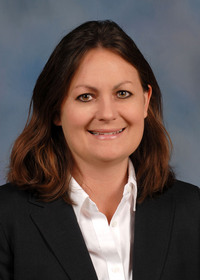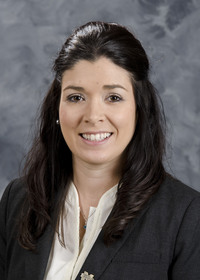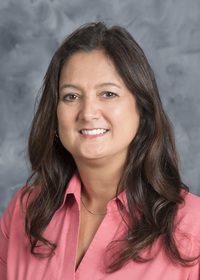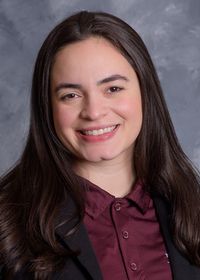The Estrous Cycle of Cattle
The estrous cycle of cattle is the period from one estrus (heat, phase of sexual receptivity) to the next estrus. For the cow and heifer, this period averages 21 days, with a typical range of 18 to 24 days. The reproductive function of a cow or heifer is characterized by whether she displays normal estrous cycles.
Stages of Female Reproduction
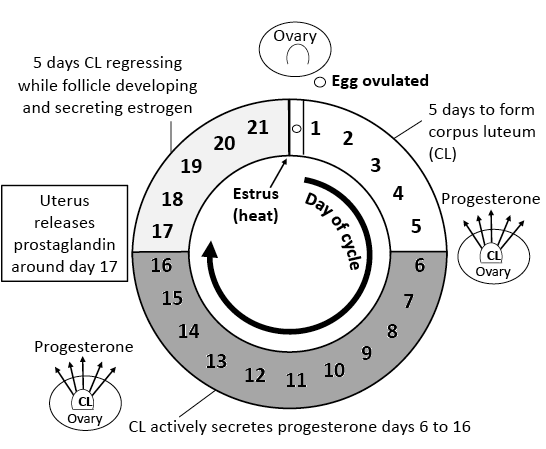
Bovine females progress through a series of stages of reproduction (Figure 1 and Table 1). They begin as prepubertal heifers that have not had their first estrous cycles. At about 11 months of age, on average, heifers typically reach puberty, or first estrus. Age at puberty depends on genetics and weight. British and Continental breeds tend to reach puberty sooner than American breeds. Nutritional management that produces lower weight gains can delay onset of puberty. To calve at 2 years of age, a heifer must reach puberty by 14 to 15 months of age and conceive. After puberty, a female then exhibits continued estrous cycles at even intervals, normally every 18 to 24 days.
During gestation, the period between fertilization and parturition (calving), a cow or heifer is pregnant and not cycling. After approximately 283 days of gestation, parturition occurs. The postpartum stage is the period of recovery after a female calves, typically 40 days or more. A beef female has approximately 82 days between calving and rebreeding to maintain an annual calving interval.
Periods when a cow or heifer does not display estrous cycles are referred to as “anestrous” or “acyclic.” These periods are most common before puberty in heifers and after calving for cows. The duration of these periods can be shortened by maintaining good nutrition and proper health management. When a cow or heifer exhibits an estrous cycle of normal length and interval, she is referred to as “cyclic.” This should be the case after a heifer goes through puberty and after the postpartum period for a cow.
Fertility increases after the initial estrous cycle following postpartum anestrous and puberty. As a cow or heifer comes out of a period of anestrus, either prepubertal or postpartum, the first estrus (heat) is “silent.” That means ovulation occurs, but she does not exhibit estrus behavior or stand to be mounted. Fertility is decreased, and the cycle is short (14 to 16 days).
|
Stage |
Description |
|
Prepubertal |
Noncycling, growing heifers |
|
Puberty |
First estrus (begins normal cycles) |
|
Estrous cycles |
Continued cycles with even intervals |
|
Gestation |
Pregnancy (not cycling) |
|
Parturition |
Birth (calving) |
|
Postpartum |
Recovery after calving (not cycling) |
Hormone and Ovarian Activity
Ovulation is the rupturing of the follicle that releases the ovum (egg) and the beginning of the estrous cycle. The same hormones control the timing of behavioral estrus (heat) and ovulation. This is important because the bull (or artificial insemination technician) must know the best time to deposit semen for optimum fertility.
The tissue of the newly ruptured follicle does not just go away. It continues to have an important function by turning into the corpus luteum (CL) by approximately day 5 of the estrous cycle.
The newly formed CL begins to produce progesterone, a steroid hormone that must be in the blood to establish and maintain pregnancy.
A timing mechanism is in place to remove (lyse) the CL if a pregnancy does not result from the previous ovulation. This timing mechanism is housed in the uterus, which produces another hormone, prostaglandin F2α (PG), around day 17 of the estrous cycle. Prostaglandin F2α lyses (ruptures) the CL and causes it to regress in about 3 to 5 days.
In the event of a pregnancy, the embryo prevents the uterus from releasing PG, and progesterone release from the CL continues. Cycling ends (the next ovulation and estrus are blocked), and the pregnancy is maintained. In a normal, healthy pregnancy, the embryo develops into a fetus. The fetus is born as a calf about 283 days after the egg was fertilized.
Another important issue is the growth of follicles before ovulation. This involves more hormones, which are produced by a gland located under the brain. These hormones travel through the blood to the ovary to direct follicular growth. They are follicle-stimulating hormone (FSH; green line) and luteinizing hormone (LH).
When FSH is released, it stimulates a group of follicles to grow (recruitment). These follicles continue to grow, although some eventually die off and regress, until only one remains and matures enough to ovulate. However, if the other hormones are not at the correct concentration, the follicle fails to ovulate and regresses. When this happens, a new group of follicles is recruited, and the process starts again.
After recruitment of a group of follicles, LH is responsible for keeping them growing. As previously mentioned, many of the follicles die off until only one is left to mature. If progesterone is not gone from the blood when that one follicle is ready to ovulate, it also regresses and recruits a new group of follicles.
Luteinizing hormone is also the hormone that stimulates ovulation. If progesterone is gone from the blood (CL has been lysed), LH is allowed to reach a greater concentration in the blood and triggers ovulation. Gonadotropin-releasing hormone (GnRH) controls the release of both FSH and LH, which is why an injection of GnRH can lead to ovulation.
Usually, two or three groups of follicles are recruited before the CL is gone and ovulation occurs.
Estrogen, produced by the follicle, travels to the brain to stimulate that final rise in LH that triggers ovulation. This estrogen also changes the behavior of the heifer or cow to make her sexually receptive. She stands to be mounted by another cow or heifer and stands to be serviced by a bull.
Progesterone is dominant during the middle of the cycle but is removed toward the end of the cycle (CL lysed) by PG. This allows estrogen to increase and trigger ovulation and estrus.
Conclusions
A sound understanding of the estrous cycle allows cattle producers to troubleshoot reproductive problems. That understanding is also important when using estrous synchronization and other reproductive technologies. Detailed information on heat detection is available in MSU Extension Publication 2610 Estrus (Heat) Detection in Cattle. MSU Extension Publication 2614 Estrous Synchronization in Cattle gives information on estrous synchronization. For more information on cattle reproduction or related topics, contact your local county MSU Extension office.
Publication 2616 (POD-06-23)
Reviewed by Brandi Karisch, PhD, Associate Extension/Research Professor, Animal and Dairy Sciences. Written by Jane A. Parish, PhD, Professor and Head, North Mississippi Research and Extension Center; Jamie E. Larson, PhD, Interim Assistant Director and Professor, Animal and Dairy Sciences; and Rhonda C. Vann, PhD, Research Professor, Animal and Dairy Sciences.
The Mississippi State University Extension Service is working to ensure all web content is accessible to all users. If you need assistance accessing any of our content, please email the webteam or call 662-325-2262.


